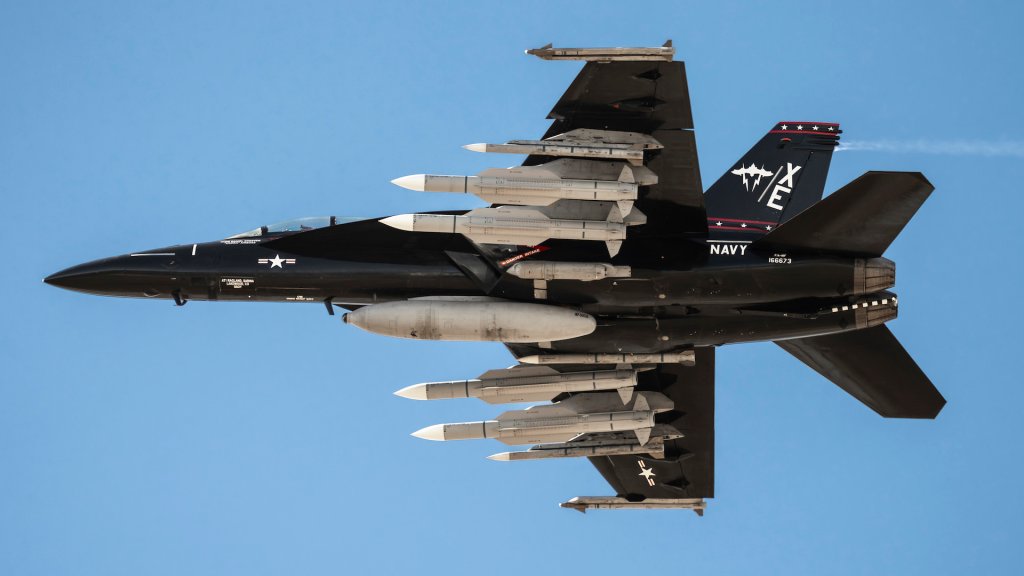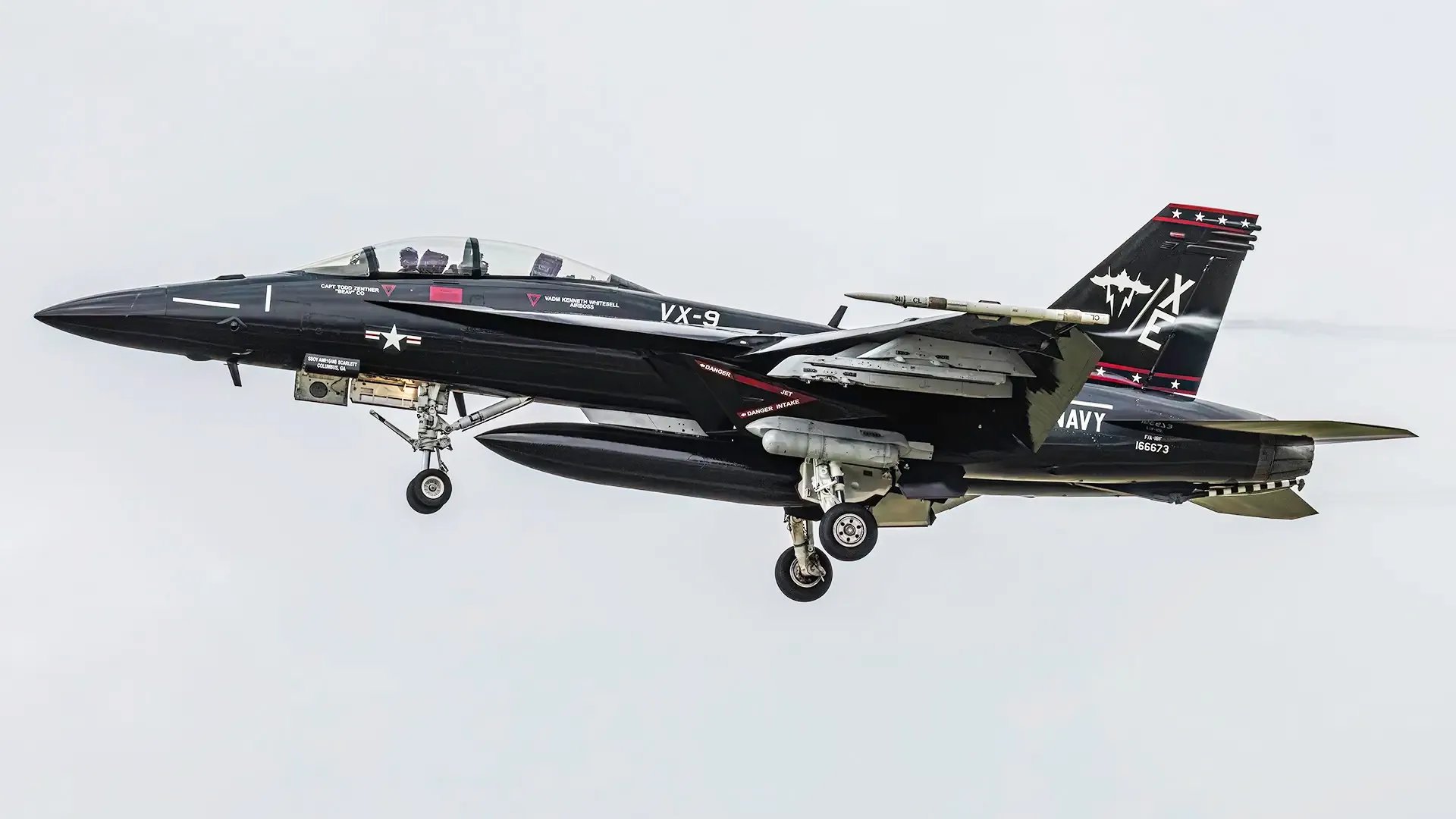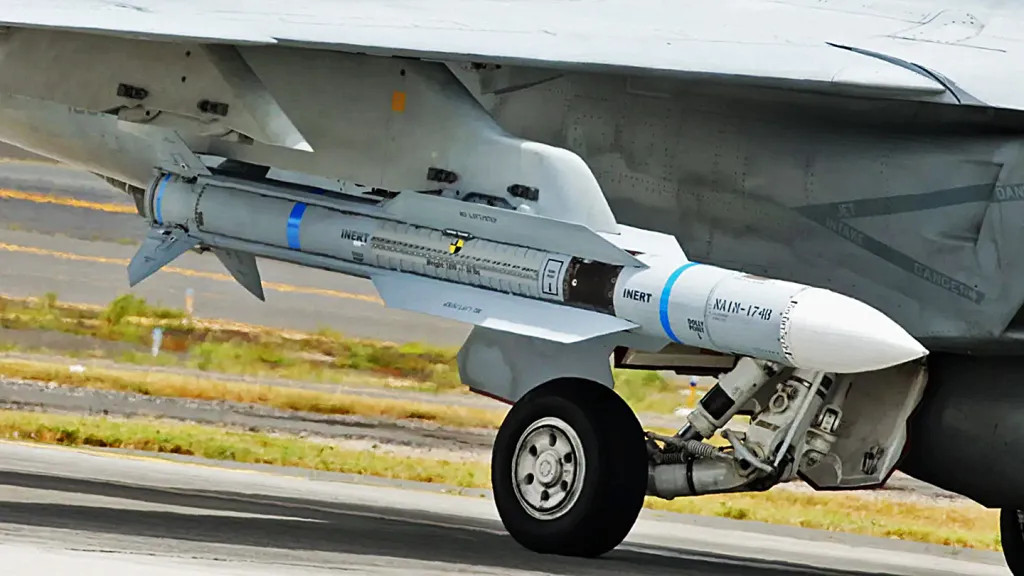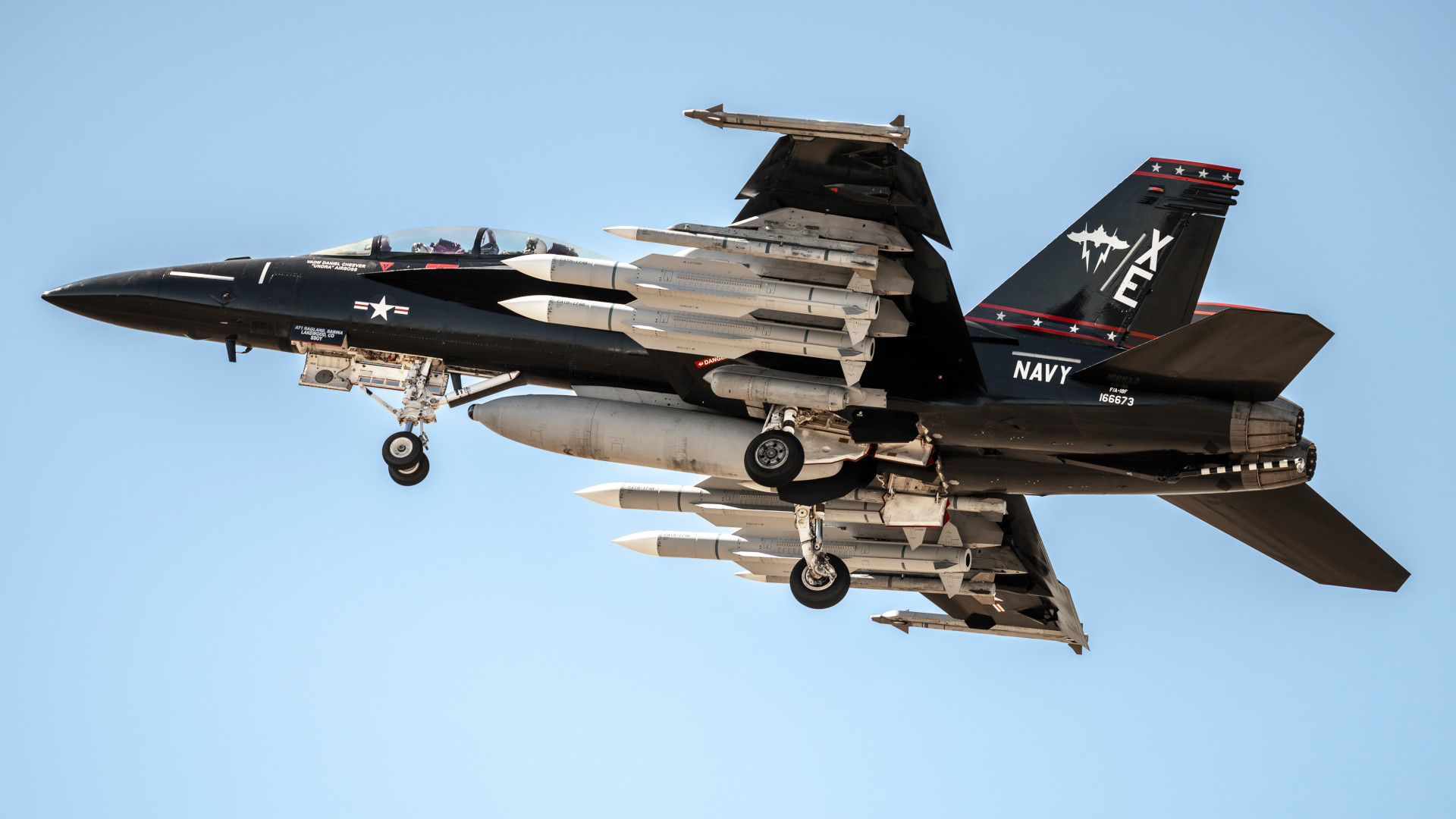A series of photos have emerged showing a U.S. Navy F/A-18F Super Hornet with a remarkable and hitherto unseen air-to-air load-out, including four of the very long-range AIM-174B air-to-air missiles. The fighter is also loaded with three medium-range AIM-120 AMRAAMs, and a pair of short-range AIM-9X Sidewinders, along with an infrared search and track system (IRST) and an ATFLIR targeting pod. Taken together, the air-to-air capability shown in this photo is unlike anything that has come before.
The original source of the photos is point_mugu_skies on Instagram, who was kind enough to share the images with us.

The identity of the aircraft is clear — it is the distinctive gloss-black, retro-scheme F/A-18F of Air Test and Evaluation Squadron Nine (VX-9) “Vampires,” which is home stationed at Naval Air Weapons Station (NAWS) China Lake, California. You can read more about that aircraft here.

As for the mixed load of weapons, these all appear to be inert rounds, as indicated by blue marking bands. Markings are visible on the AIM-174s that show they are technically “captive” CATM-174Bs not capable of being fired.

The four large missiles carried under the aircraft’s wings are training versions of the Navy’s air-launched variant of the multi-role, long-range surface-launched SM-6 missile, the AIM-174B, the existence of which was only officially acknowledged this summer and that is said to be in operational service on some level. TWZ has closely followed the emergence of this weapon from the shadows and in this previous article, we explored in detail how it fits into the Navy’s master plan for countering China in the air-to-air combat arena.

The missiles carried on the Super Hornet’s wingtip stations are variants of the infrared-guided AIM-9X Sidewinder, the standard short-range air-to-air missile armament for U.S. combat jets, which is now being produced in an upgraded Block II form.
Meanwhile, on the right-hand under-fuselage ‘shoulder’ station and on each of the outboard underwing stations is a version of the AIM-120 Advanced Medium Range Air-to-Air Missile (AMRAAM), a radar-guided medium-range weapon that is both ubiquitous and combat-proven. These missiles lack the mid-body fins found on a regular live AMRAAM, but captive versions of the missile don’t necessarily have fins fitted anyway.

Without a doubt, the AIM-174B is an incredibly important program for the U.S. Navy, being squarely aimed at China’s burgeoning air power capabilities, especially the fact that its fighters are beginning to outrange American fighters with their own advanced air-to-air missiles. Russia, too, has been busy developing air-to-air weapons with ranges that potentially far outstrip their Western equivalents.
Alongside the missiles, it should also be noted that the Super Hornet carries an infrared search and track system, or IRST, on the centerline station. The complete IRST system consists of an FPU-13 drop tank with the IRST21, also known as the AN/ASG-34, installed in the front portion — you can read more about it here. The Navy’s IRST has struggled during development, but the most recent plan has been for an improved Block II version to reach initial operational capability in the fourth fiscal quarter of 2024, which ends this month.
Finally, on the left-hand under-fuselage ‘shoulder’ station is an AN/ASQ-228 Advanced Targeting Forward-Looking Infrared (ATFLIR) targeting pod.

The IRST is an increasingly important tool in the air-to-air combat arena, especially for detecting stealthy platforms. The ATFLIR, too, has an air combat role, including providing visuals of distant aerial targets for identification friend or foe (IFF) purposes.
Four AIM-174Bs, three AMRAAMs, and two AIM-9X, as well as targeting and IRST pods, is, by any measure, a very impressive load-out, albeit one that has penalties when it comes to operational logistics. That load, including a full drum of 20mm ammo, weighs well over roughly 16,000-pounds, which is very heavy even for the Super Hornet, and induces a lot of drag. This means on-station time would be limited without consistent tanker support, but for some missions, like fleet defense, this would make a lot of sense, and even projecting AIM-174 capability forward to take out force multiplier platforms, like airborne early warning and control, electronic surveillance and electronic warfare, tanker, and other prized platforms over long distances. You can read out past in-depth analysis, which has been parroted across the internet, on this weapon and its impact on future fights, especially in regard to bursting China’s anti-access bubble, here.
It’s also worth noting that in the near future, the AIM-120s seen in this shot could be the now deep-in-development AIM-260 Joint Advanced Tactical Missile (JATM), with even longer range and advanced capabilities. Still, the AIM-120 in its latest configuration is now approaching the threshold range for the JATM, according to Raytheon. Regardless, the option to mix in the AIM-260, with the Super Hornet being one of the first aircraft to get it in the near future, will only make such an air-to-air loadout more potent.
As to exactly what the heavily armed F/A-18F was doing when photographed, one highly likely explanation is that it is preparing for involvement in the next Gray Flag exercise, expected to begin next week. As we have discussed in the past, this is a test and evaluation exercise series, which would explain VX-9’s presence at Point Mugu, although the unit operates out of the sprawling installation for other purposes too as part of its test mission. Moreover, previous editions of these maneuvers have placed a heavy focus on various advanced capabilities intended to challenge the ability of enemy forces to spot, track, and target friendly aircraft. Once again, testing of the AIM-174B — and other air-to-air capabilities — would make a lot of sense within this context, as would the IRST.
If anything else, the image of VX-9 carrying such a remarkable and diverse air-to-air payload is another sign of the work that is being rushed in an attempt to get a leg-up in aerial combat in this new era of so-called ‘great power competition,’ and especially when it comes to China’s area-denial strategy that extends far out into the Pacific.
Contact the author: thomas@thewarzone.com
